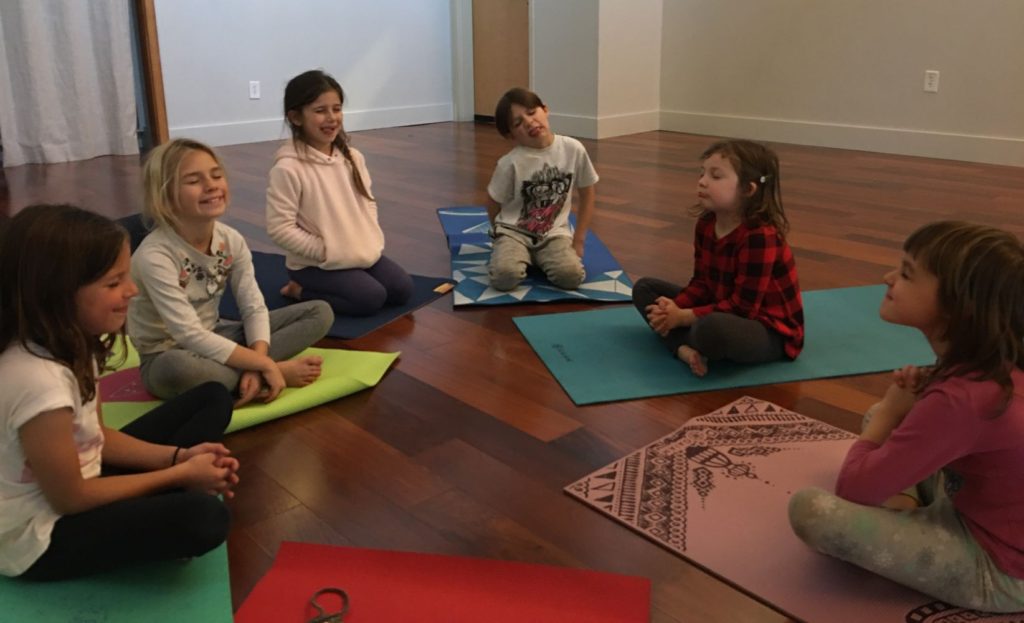When we talk about kids’ emotions, we tend to zoom in mostly on the naughty, instead of nice, expressions of a youth’s feelings. Toddlers throw tantrums, teens are moody, and, overall, young people’s emotions are more intense than the adults’. Even if all of these generalizations are true and scientifically sound, they still focus on the behavior rather than the emotions themselves.
Working with children ranging from four years old to teenagers, including students with special needs, my goal is to guide them to get in touch with their inner world and find a unique way of experiencing and expressing it. The creative mindfulness practices first build the emotional awareness kids need in order to recognize and embrace their own feelings. The next step to raise their emotional intelligence is to help them identify the feelings of others and master empathy.
What makes a mindfulness practice effective (for kids and for all who are not afraid to keep the inner child vibrant) are the following:
- It needs to be creative.
- It must play to the child’s unique strengths.
- It has to be fun!

Here are a few playful approaches:
Mindfulness Through Senses
We start with listening. The children close their eyes and pay attention to the sound of a bell or singing bowl. When they don’t hear it anymore, they make a face to express how they feel at the moment. Keeping their eyes closed helps them be more honest in their emotional expression and allows them to be as goofy as they would like! Then, we take a few deep belly breaths together and repeat the practice, but this time, the children have to express how they want to feel. Through this approach, they learn to bounce easier between a sympathetic and a parasympathetic response. We may also add a story to the practice to deepen the experience. While reading a book, we pause, take a few breaths together, then express how the main character might be feeling in the moment. It’s an opportunity for kids to reflect on the story and help them decipher emotions while recognizing somebody else’s feelings, ultimately teaching them empathy.
Mindfulness Through Creativity
Any kind of art, for instance painting, music, dance, pottery-making, or theater, can be emotionally releasing. As long as they resonate with the child, all of those examples are forms of creative expression. Even math (not technically an art) can be a powerful tool for creative expression – if it’s a student’s strength. With my math prodigy students, we count our breaths in fives or hundreds, or even backward, and our arms and legs move at exact angles – creativity expressed through precision.
“Where I Feel an Emotion”
Children search for a body sensation and place their hands there. Where do we feel joy? How about love? Sadness? Through the practice, they learn to become mindful of their physical sensations in connection to their emotional experiences. This practice can also be combined with reading a story. Often, to get in touch with their own emotions, it feels safer for children to use a character in a book, an imaginary friend, or their favorite toy. Still, in this process, they not only become more aware of their inner experiences, but also grow more sensitive (and therefore, empathetic) to other’s feelings.
Playing with Colors
There is a whole scientific field on how colors impact the way we feel and behave. In TCM, each main organ is associated with an emotion and a particular color. In yoga, we have the chakra system, which also assigns a specific color to each energy gate.
- What color was your day? Kids love to describe their experiences in colors. Nature is bright, and children know how to appreciate it.
- Paint the room the color of happy, calm, grateful, or any other emotions we want to play with. We combine the visualization with movements, mindfully following our imaginary paint brush strokes on the wall. Many techniques create a safe space, but I find this one particularly effective (probably because it reverberates with children’s playfulness and creativity).
- Shaping our emotions. Kids have an abundance of imagination, and we tap into it with this practice. Here, our emotions take the form of a balloon animal. We “blow” as many imaginary balloons as we might need to form our animal, which expresses a particular feeling. After the breathing exercise, we start “making” the balloon creations. Then, students pretend to hold them in their hands and describe them. Often what starts as an expression of a negative emotion, eventually takes the shape of an imaginary emotional support animal. The calming effect of the breath has a positive impact on the creative process. We finish with a practice of letting go of the feeling and releasing the animal, either by blowing the balloon so it flies away, or inflating until it bursts (this one is always fun). Just like our emotions, the imaginary animals are no longer a part of us; we observe them, perhaps enjoy them for a bit, then set them free.
















